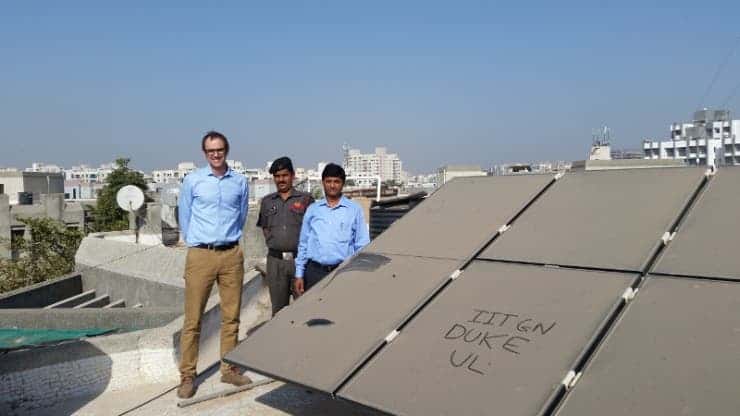Grit and grime can cut solar panels’ output by more than 35% in certain areas of the globe, a new paper reports.

Cleanliness may be next to godliness, but more to the point, it’s just good business. That’s according to the results of a new study led by Duke University professor of engineering Michael Bergin, who looked at the impact dust and other types of air pollutants have on the output of solar panels. The findings show that the accumulation of airborne particles (both in the shape of dust and anthropic pollution) on solar cells can grind their output down by more than 25% in certain regions. The most affected countries are also those who are investing most heavily in solar energy, such as China, India, and countries in the Arabian Peninsula.
[button url=”https://lp.understandsolar.com/ro/core/?lead_source=zmescience&tracking_code=dusty_solar” postid=”” style=”btn-success” size=”btn-lg” target=”_blank” fullwidth=”true”]Find out how much a solar roof can save you in your area[/button]
Dusty
Working with researchers at the Indian Institute of Technology-Gandhinagar (IITGN) and the University of Wisconsin at Madison, Bergin measured the drop in power output in IITGN’s solar panels over time, as they built up dust and dirt.
“My colleagues in India were showing off some of their rooftop solar installations, and I was blown away by how dirty the panels were,” professor Bergin said.
“I thought the dirt had to affect their efficiencies, but there weren’t any studies out there estimating the losses. So we put together a comprehensive model to do just that.”
The numbers showed that cleaning the panels after a few weeks of getting dirty would lead to a 50% increase in their efficiency. The team also sampled the grime layer to see what it was made of. Analysis revealed that some 92% of particles were regular, run of the mill dust, with the rest being composed of anthropic-sourced carbon and ion pollutants. The latter, despite making up only 8% of the whole, are much more powerful at blocking sunlight that natural dust. All in all, the team estimates, human contribution in solar cell energy loss roughly equal to that of natural pollutants. Anthropic particles are also smaller and stickier, making them difficult to clean off, and potentially posing a risk for the panels’ proper functioning.
“You might think you could just clean the solar panels more often, but the more you clean them, the higher your risk of damaging them.”
Dirt and grime aren’t the only things slashing solar efficiency, however. To assess the part atmosphere-borne particles play in blocking sunlight from reaching the cells, the team worked with Drew Shindell, professor of climate sciences at Duke and an expert in using the NASA GISS Global Climate Model. Starting from the model, which accounts for airborne-particle reflection of incoming solar energy, he could estimate how much light they would prevent from reaching the panels. The NASA model also estimates the amount of particulate matter deposited on surfaces worldwide, offering a handy avenue for the team to calculate how much sunlight would be blocked by accumulated dust and pollution.

Image credits Bergin et al., 2017.
Finally, Bergin drew on his previous research of analyzing how pollutants are discoloring India’s Taj Mahal to put together a model that describes how much sunlight gets blocked by different compositions of solar panel dust and pollution buildup. This model can be used to estimate the total loss of solar energy output in any part of the world.
[button url=”https://lp.understandsolar.com/ro/core/?lead_source=zmescience&tracking_code=dusty_solar” postid=”” style=”btn-success” size=”btn-lg” target=”_blank” fullwidth=”true”]Find out how much a solar roof can save you in your area[/button]
For example, the US has relatively little dust and sees only small reductions in power due to dusty build-ups. By contrast, more arid regions such as the Arabian Peninsula, Northern India, and Eastern China can see heavy losses: 17% to 25% or even more, if cleaning is only performed on a monthly basis. For one cleaning per every two months, losses can jump to 25%, even edging over 35%. These numbers can certainly be influenced by local or regional factors which the paper can’t foresee. A nearby building site, for example, would create a large quantity of airborne and deposited particles for a solar array.
The composition also matters, and its effects vary from place to place. The Arabian Peninsula, the team writes, loses much more output to dust than to anthropic pollutants. Some regions of China and of India, however, see more losses due to the latter.
“China is already looking at tens of billions of dollars being lost each year, with more than 80 percent of that coming from losses due to pollution,” said Bergin. “With the explosion of renewables taking place in China and their recent commitment to expanding their solar power capacity, that number is only going to go up.”
“We always knew these pollutants were bad for human health and climate change, but now we’ve shown how bad they are for solar energy as well,” he added. “It’s yet another reason for policymakers worldwide to adopt emissions controls.”
The paper “Large Reductions in Solar Energy Production Due to Dust and Particulate Air Pollution” has been published in the journal Environmental Science & Technology Letters.


